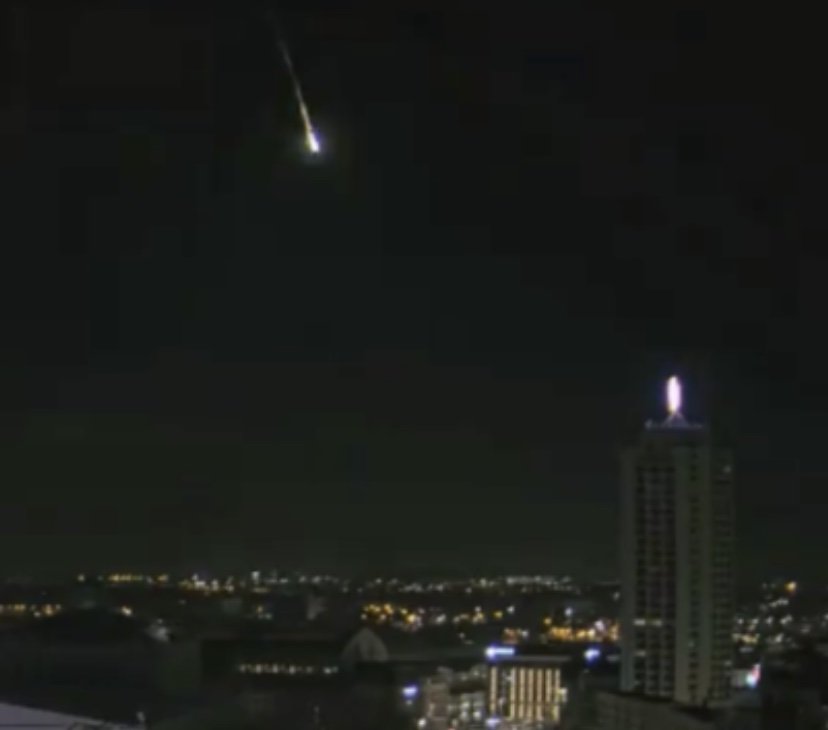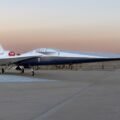

Welcome to this week’s installment of The Intelligence Brief… recently, NASA’s Scout impact assessment system succeeded in calculating the trajectory of an asteroid that entered Earth’s atmosphere over Germany. In our analysis this week, we’ll be looking at 1) how NASA made the detection, and what we know about the circumstances surrounding the incident, 2) details about the Scout system, and how it works, and 3) rapid response and mitigation strategies for future potentially deadly asteroid events.
Quote of the Week
“If the dinosaurs had a space program, they would not be extinct.”
– Carl Sagan
Latest News: In recent coverage from The Debrief, the UK Ministry of Defense has announced the first successful downing of an aerial threat using its DragonFire combat laser system. Speaking of lasers, NASA also recently revealed that a laser beam was fired from its Lunar Reconnaissance Orbiter (LRO) at a spacecraft on the Moon’s surface. We reveal the reason why, and much more. You’ll find links to all our recent stories and other items at the end of this newsletter.
Podcasts: In podcasts from The Debrief, on The Debrief Weekly Report, MJ, Steph, and Kenna Castleberry travel deep into the Amazon rainforest in search of a hidden and elusive 2,500-year-old civilization. Meanwhile, this week on The Micah Hanks Program I look at the idea of whether there is a technological “quickening” as humanity careens toward an uncertain future, as I am joined for a wide-reaching discussion by author Whitley Strieber. You can get all of The Debrief’s podcasts by heading over to our Podcasts Page.
Video News: In the latest installment of Rebelliously Curious, Chrissy Newton is joined by computer scientist Jaques Vallée for an in-depth discussion about the intersection between AI and the U.S. government’s studies of UAP. You can check out this, and other great content from The Debrief on our official YouTube Channel.
With housekeeping behind us, it’s time to look at a recent event involving a space object that approached Earth, and how NASA was able to get the word out about its approach well ahead of time.
Advance Detection of an Asteroid Impact
In the early morning hours of Sunday, January 21, an asteroid approached Earth, colliding with the atmosphere over Germany and disintegrating at 1:32 a.m. local time.
The asteroid, later designated 2024 BX1, was first spotted within three hours of its impact with Earth’s atmosphere by Krisztián Sárneczky at the Piszkéstető Mountain Station of the Konkoly Observatory near Budapest, Hungary. At no time did the small space object, roughly three feet wide, ever pose a threat to anyone on the ground.


Similar events involving innocuous asteroids occur frequently, so it’s easy to understand why some would question what made this space object any different. The simple reason is that about an hour and a half before the asteroid made impact with Earth’s atmosphere, it was detected by NASA’s Scout impact hazard system, marking a notable step toward being able to provide advance warning about where future, potentially deadly asteroid impacts might occur.
Scouting for Deadly Asteroids
According to NASA’s Center for Near Earth Object Studies, Scout offers trajectory analysis and hazard assessment for objects detected on the Near-Earth Object Confirmation Page (NEOCP) maintained by the Minor Planet Center. “Scout continually monitors the objects on the NEOCP, and for each provides the following orbital, ephemeris, and hazard assessment information,” a summary of the program reads.
Although objects on the NEOCP page are unconfirmed, they represent potential space objects that can be confirmed as asteroids through additional observations. Once verified, the objects are given official designations and are removed from the NEOCP and Scout.
Scout succeeded in detecting the object that burned up over Germany, producing a bright fireball that observers on the ground as far away as the Czech Republic reportedly observed. Although the primary asteroid was destroyed during reentry, NASA says that smaller meteorite fragments may have reached the ground to the west of Berlin.
Congress has tasked NASA with reporting on essentially all near-Earth objects, or NEOs, regardless of size, although NEOs 140 meters and larger are the ones deemed a serious hazard if an impact were to occur. Fortunately, these are much larger than 2024 BX1, and despite its small size, the recent impact clearly demonstrated Scout’s capabilities.
Rapid Response in Tracking NEOs
Within 27 minutes, three observations of 2024 BX1 made their way to the NEOCP, allowing Scout to identify that an impact was possible. Fortunately, in this case, the rapid response from astronomers quickly ruled out any significant chance of danger resulting from the asteroid, although a 100% probability of impact with the atmosphere was determined within seventy minutes of the object’s first detection.
Many observers in Germany and surrounding areas observed the event, and photos of 2024 BX1’s disintegration appeared online shortly after the incident.


2024 BX1 is not the first asteroid that has been tracked before impacting Earth’s atmosphere. In October 2008, a similar, but slightly larger object (approximately 13 feet across) designated 2008 TC3, also entered Earth’s atmosphere and produced a fireball as it broke up over Sudan. Another incident occurred last year when 2023 CX1 was detected just seven hours before impacting Earth’s atmosphere over France.
Fortunately, Scout has proven effective at spotting these objects, all of which were far too small to pose a threat. If a larger object were to approach and an impact with the planet became inevitable, warnings could be issued in advance based on the object’s trajectory, and residents in the anticipated impact zone may potentially have time to evacuate or take other necessary action.
For now, detecting smaller objects like 2024 BX1 and its predecessors is not only demonstrating our growing ability to warn about potentially dangerous impacts in the future, but also providing useful data that helps NASA and its partners plan for those events, and how best to mitigate the dangers they could represent in the years ahead.
That concludes this week’s installment of The Intelligence Brief. You can read past editions of The Intelligence Brief at our website, or if you found this installment online, don’t forget to subscribe and get future email editions from us here. Also, if you have a tip or other information you’d like to send along directly to me, you can email me at micah [@] thedebrief [dot] org, or Tweet at me @MicahHanks.


Here are the top stories we’re covering right now…
- NASA’s Lunar Reconnaissance Orbiter Fired a Laser at a Spacecraft on the Moon. Here’s the Reason Why.
NASA recently revealed that a laser beam was fired from its Lunar Reconnaissance Orbiter (LRO) at a spacecraft on the Moon’s surface.
- UK Ministry of Defense Says High-Powered DragonFire Combat Laser Successfully Downed Aerial Target
The UK Ministry of Defense has announced the first successful downing of an aerial threat using its DragonFire combat laser system.
- Miracle Filtration System Marks Quantum-Leap in Global Access to Clean Drinking Water Using This Revolutionary Biomaterial
A new ‘miracle’ portable water filtration system could make clean drinking water available to people around the world.
- Sci-Fi Nightmare? These Insect-inspired Micro-Robots are the Smallest, Lightest, and Fastest Ever Built
Like something right out of a science fiction nightmare, Washington State University engineers have created a pair of insect-inspired micro-robots that are the smallest, lightest, and fastest ever built.
- To Pew or Not to Pew, That is the Question
On today’s episode, the team travels deep into the Amazon rainforest in search of a hidden and elusive 2,500 year old civilization.
- At Just 54 Atoms, Scientists Made History by Tying the World’s Smallest Knot, and They Have No Idea How They Did It
An international team of chemists has set a new world record for tying the world’s smallest knot, which they say consists of only 54 atoms.
- Scientists Successfully Trap Individual Krypton Atoms to Create the First-Ever One-Dimensional Gas
For the first time ever, researchers from the University of Nottingham have successfully trapped individual atoms of krypton to create a one-dimensional gas.
- Researchers Examine Whether Violent Video Games Numb People to Real-World Violence
A team of international researchers took a closer look at violent video games to see if the adversely affect empathy by numbing players to real-world violence.
- 200-Million-Years Ago, These Winged ‘Dragons’ Glided Through England’s Ancient Skies
On an ancient subtropical island that once existed near modern-day South West England, a species of winged creatures that closely resembled tiny dragons once thrived, new research has revealed.
- Raytheon is Building Two Ultra-High Power Directed Energy Weapons for the U.S. Navy and Air Force
Raytheon has been tasked to design, build, and test a pair of ultra-high powered directed energy weapons for the U.S. Navy and Air Force.
- “Hazards Remain High” as Volcanic Danger Zone is Revealed in NASA Satellite Imagery Captured Over Iceland
NASA satellite imagery has revealed the thermal signature of volcanic activity that reawakened on Iceland’s Reykjanes peninsula this month, following an eruption late last year that prompted evacuations.
- Something ‘Anomalous’ on the Moon’s Surface is Exhibiting ‘Unique’ Magnetic and Reflective Properties
Researchers studying over one million digital photos have found something anomalous on the Moon’s surface that exhibits unique magnetic and reflective properties.
- James Webb Space Telescope Has Helped Solve a Mystery That Left Astronomers Baffled For Years
One of astronomy’s most perplexing mysteries has been resolved, according to scientists involved with new findings made possible by NASA’s James Webb Space Telescope.
- Jacques Vallée Examines the Simultaneous Emergence of Al and UAP
Jacques Vallée shares his thoughts on the current state of AI and UAPs, exploring what excites him but also concerns him about their present and future state.
- Coincidences of Our Sun and Moon: Are Earthlings Exceptionally Lucky?
Was the Moon-Sun tidal coincidence on Earth important for allowing complex and intelligent life?
- 13-Billion-Year-Old Black Hole is the Oldest Ever Observed, and It Has a Monstrous Appetite
Astronomers have detected the oldest black hole ever observed, dating back to just 400 million years after the Big Bang.
- The Vanishing Star Enigma and the 1952 Washington D.C. UFO Wave
Astronomer Beatriz Villarroel examines the enigma of “vanishing stars” in relation to the famous 1952 Washington D.C. UFO incident.
- Salvatore Pais’s Mysterious ‘UFO patents’: What Do They Really Mean?
Whatever technologies these “UFO patents” may represent, they aren’t reverse-engineered UAP technology, argues philosopher Bernardo Kastrup.
- Unknown Object Punched “Softball Sized Hole” in Aircraft, Prompting Emergency Landing and FAA Investigation
The FAA is investigating an incident that prompted the emergency landing of an Atlas Air flight at Miami International Airport late Thursday evening, leaving a hole above one of its engines.
- Engineers Develop ‘Breakthrough’ Method for Creating Infinitesimally Small Objects Using the Power of Light
Engineers have harnessed the power of light to print metallic nanostructures faster and cheaper than ever before.
- Scientists Have Revealed a Crucial Step in How Early Life May Have Originated on Our Planet, and Earth Isn’t the Only Place it Could be Happening.
New research is offering potentially crucial insights into how living organisms came to exist on our planet billions of years ago.
- Astronomers Baffled by a Mysterious Object in the “Mass Gap” Between Neutron Stars and Black Holes
Researchers from the Max Planck Institute in Germany have spotted an unknown object in the mass gap between neutron stars and black holes.
- These Pests Have Evolved a Resistance to Farming Insecticide, New Study Reveals
Researchers have documented the first-ever case of insecticide resistance in field-collected populations of a bluegreen aphid.
- Japanese Startup Testing Ground-Based Fusion Laser in Pioneering Effort to Combat Space Debris and Orbital Threats
A Japanese start-up is planning to test a ground-based fusion laser to combat the growing threat of space debris.
- Northwestern Researchers Invent an Incredible Power-Generating Fuel Cell That Runs on Dirt
Engineers have created an innovative fuel cell that runs on dirt by capitalizing on the novel power-generating capabilities of microbes.
- Groundbreaking New Study Reveals Origins of Intense Unexplained Phenomena Caused by Supermassive Black Holes
New simulations have replicated a phenomenon associated with supermassive black holes, revealing something as yet unknown to astronomers.
- Will Scientists Soon Confirm the Existence of Alien Life?
This week, tantalizing hints that a major scientific discovery involving alien life may be on the way are afoot… but is there more here than hype?
- Classified: The Intelligence Community UAP Briefing
Recently, members of Congress received a classified briefing from the Intelligence Community Inspector General regarding unidentified anomalous phenomena (UAP).
- 14,000 Years Ago, Ancient Humans Tracked, Hunted and Killed This Massive Land Animal
Mounting evidence indicates that 14,000 years ago ancient humans in Alaska tracked, hunted, and killed this massive land animal.
- 3000-Year-Old Carvings on Enigmatic Disk Unearthed in Italy Could Be Ancient Star Map, Controversial Study Claims
A stone disk bearing peculiar markings could be an ancient star map, according to new claims that prompted debate among archaeologists.
